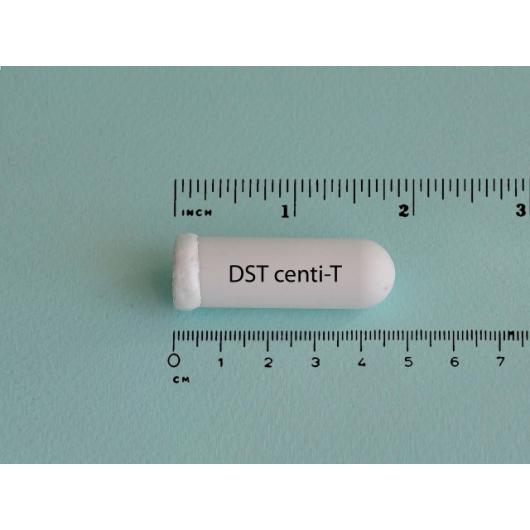Key features:
- Self-contained temperature logger ideal for use in environmental temperature monitoring
- High pressure survival up to 3000 m depth
- Biocompatible housing suitable for implantation in animals
- Long battery life of 9 years
- Small sized logger with dimensions 46 mm x 15 mm
- Large memory of 174 000 measurements (can be extended)
Description
The DST centi-T is a miniature submersible temperature data logger. Recorded data is stored in its internal memory with a real-time clock reference for each measurement.
The self-contained temperature logger is supported by the SeaStar software and the Communication Box which serves as an interface between the logger and a PC. Communication between the logger and the Communication Box is wireless.
In SeaStar, the user sets the start time, start date and sampling interval before starting the recorder. Up to seven different intervals can be set for the same measurement sequence. This is especially useful when more frequent measurements are needed at a certain time period.
After recovering the DST recorded data is uploaded via to SeaStar where results are displayed both in graphic and tabular form. After retrieving the data, the DST can be re-programmed and reused as long as the battery lasts.
A set of Communication Box and SeaStar software needs to be purchased with the first order.
Star-Oddi also offers protective logger housings for use at fixed locations or harsh environments.
Features on Request
Extended memory
DST centi-T and DST centi-TD can be delivered with an extended memory capacity of 523,800 measurements in total (DST centi-ex).
Temperature calibration outside standard range
Temperature calibration outside of standard ranges or for smaller ranges is available for all products on request.
Examples of applications
DST centi-T is mostly used as a stand-alone logger for sampling temperature in underwater environments, attached to deployment lines, moorings or other gear. It can also be used for measuring temperature in soil or air. Another usage is measuring temperature values in animals. The DST centi-T can be implanted in animals. The housing is made of biocampitible material.
The DST centi-T temperature logger is used for various studies, for example:
- Temperature fluctuations in animals
- Thermistor chain in water columns
- Temperature monitoring in oceans, rivers and lakes
- Agricultural research projects
- Aquaculture studies
- Sensor: temperature
- Size (diameter x length): 15mm x 46mm
- Housing material: alumina (ceramic)
- Weight (in air/in water): 19g/12g
- Data resolution: 12 bits
- Temperature range: 5 to +45°c (32°f to 113°f)
- Temperature resolution: 0.032°c (0.058°f)
- Temperature accuracy: +/-0.1°c (0.18°f)
- Temperature response time: time constant (63%) reached in 20 sec.
- Memory type: non-volatile eeprom
- Memory capacity: 174,000 measurements
- Sampling interval: user specified in second(s), minute(s), or hour(s)
- Minimum measuring interval: 1 second
- Multiple intervals option: up to 7 different intervals
- Data retention: 25 years
- Clock: real time clock. Accuracy +/- 1 min/month.
- Communications: communication box, wirelss transmission when dst sits in the box. Connection to pc: usb cable
- Attachment hole: 0.9 mm (diameter)
- Battery life: 9 years*
- Replaceable battery: no
* for sampling interval of 10 minutes.
Warranty: 12 months
Specifications may change without notice.
- COMBOX Communication box with USB converter
- MERCURY Mercury software for DST system
2014
Buijs PRA, van Amerongen G, van Nieuwkoop S, Bestebroer TM, van Run PRWA, Kuiken T, Fouchier RAM, van Eijck CHJ, van den Hoogen BG.
Intravenously injected Newcastle disease virus in non-human primates is safe to use for oncolytic virotherapy.
Cancer Gene Therapy (2014) 21, 463-471.
Friebe A, Evans AL, Arnemo JM, Blanc S, Brunberg S, et al.
Factors Affecting Date of Implantation, Parturition, and Den Entry Estimated from Activity and Body Temperature in Free-Ranging Brown Bears.
PloS ONE (2014) 9(7): e101410.
2013
Hergenhan RL, Hinch GN and Ferguson DM.
Sire effects on neonatal lamb vigour and following-behaviour.
Animal Production Science (2013).


